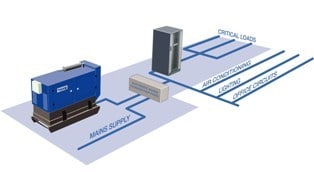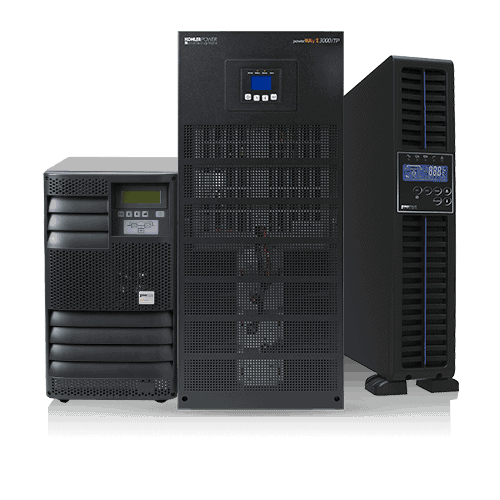KOHLER Uninterruptible Power (UPSs) perform an essential role in protecting organisations that cannot tolerate any electrical power interruption. If the mains fails, the UPS’s battery seamlessly takes over until power is restored. However, UK electricity grid problems are increasing the likelihood of extended failures that could exceed the UPS battery’s available autonomy. A standby generator and fuel supply can solve this, but unlike a UPS, a generator cannot come online seamlessly when the power fails. Therefore a matched generator – UPS pair is essential for truly uninterrupted, ongoing power protection.
To successfully install a generator, it must be matched to the UPS, sized correctly for the onsite load, and installed into an environment that is designed to accommodate it. Generator-UPS matching is important as otherwise each can cause problems for the other. Generator output voltage is usually acceptable to the UPS, but its output frequency range, under fluctuating loads, may be too wide for the UPS to accept. The generator frequency rate of change, or slew rate, may also be too fast for the UPS to follow safely. Such problems can be prevented by ensuring the generator is fitted with an electronic governor maintaining its output within tight frequency limits.
Meanwhile, UPSs typically have a rectifier charger control circuit which imposes notches on the power feed, interfering severely with some types of generator control. Additionally, some charger circuits draw non sinusoidal input current, creating harmonics, measured as total harmonic distortion (THDi). These can cause de-rating of the generators output, especially as some UPSs generate up to 30% THDi. Also, generators cannot usually tolerate 100% of their rated load being applied in a single step.
However, careful choice of UPS topology can pre-empt such problems. Transformerless technology can achieve a THDi of below 3% at full load, while a separate battery charger circuit, together with a Generator ‘On’ signal between UPS and generator reduces the UPS battery charging current, in turn reducing load, notching and heating effects on the generator. Step loading on the generator is controlled primarily by soft start of the rectifier current, eliminating high current peaks during mains recovery. Sequential switch-on of UPS rectifiers as a parallel array within the UPS is another possible way of reducing UPS step loading on the generator.
The generator must be sized for its critical load as well as matched to the UPS. This may comprise emergency lighting, air conditioning, building alarm systems and other services as well as the UPS load. For example, there is no point in maintaining power to ICT equipment without also supporting the air conditioning essential to maintaining equipment-acceptable ambient temperature. It is also good practice to work to the generator’s continuous rating rather than its higher standby rating, as it can be called upon at any time to work for any duration.
Planning the chosen generator’s installation is subject to several environmental and physical considerations. Once the autonomy has been established, the amount of fuel required and means of storage can be established. Bunding is essential to ensure fuel oil cannot leak into the water supply. Positioning of the generator is influenced by further factors that must all be allowed for. For example generator start-up and running noise may be acceptable in a given location during the day, but intolerable at night. As the mains can fail at any time, either a different location must be chosen or a ‘bespoke’ acoustic housing used. The cost of this increases with its attenuation rating.
All generators produce heat as well as power, which is mostly removed by air cooling. Therefore, generators are typically located outside, in weatherproof and acoustic enclosures, where a plentiful supply of cooling air is assured. An outside location also allows easier exhaust fume venting, obviating problems associated with installing exhaust pipes within buildings. For internal installations within buildings ventilation and noise requirements can be given using specialist acoustic equipment such as attenuators and exhaust silencers. These are often manufactured specifically for the application and the complete system assembled on-site by specialist installation engineers.
Other physical considerations are also important. Even a small 100kVA standby generator weighs several tonnes, weight which must be allowed for when planning its delivery and positioning. Special delivery vehicles and lifting equipment may be needed. The generator should also be as close as possible to the main electrical installation to minimize runs of expensive power cable, as well as volt drop losses.
Adding a generator calls for legislative compliance as well as satisfying the site’s environmental considerations. Local authority planning requirements vary with area, so it is essential to check these before installing a standby generator. If large quantities of fuel are to be stored on site then compliance with the Environment Agencies PPG02 regulation is required.
All of these factors are important to the success of adding generator capability. However, with planning none are particularly onerous, and the benefits of generator protection can far outweigh any inconvenience or cost.
This article has been published in the following:





